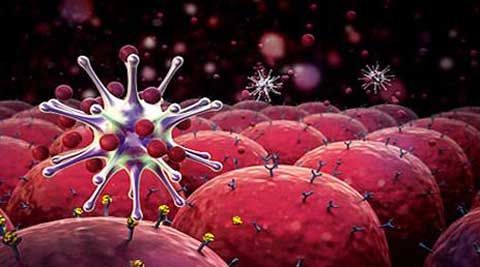Tumour ‘monorail’ may spell doom for cancer cells

Indian-origin scientists have successfully developed a radical new technique that may kill brain tumours by hijacking them into toxic pits or areas of the body that are safer to operate on.
One factor that makes glioblastoma cancers so difficult to treat is that malignant cells from the tumours spread throughout the brain by following nerve fibres and blood vessels to invade new locations. Now, researchers have learned to hijack this migratory mechanism, turning it against the cancer by using a film of nanofibres thinner than human hair to lure tumour cells away.
Instead of invading new areas, the migrating cells latch onto the specially-designed nanofibres and follow them to a location – potentially outside the brain – where they can be captured and killed. Using this technique, researchers can partially move tumours from inoperable locations to more accessible ones. Though it would not eliminate the cancer, the new technique reduced the size of brain tumours in animal models, suggesting that this form of brain cancer might one day be treated more like a chronic disease, researchers said.
“We have designed a polymer thin film nanofibre that mimics the structure of nerves and blood vessels that brain tumour cells normally use to invade other parts of the brain,” said Ravi Bellamkonda, lead investigator and chair of the Wallace H Coulter Department of Biomedical Engineering at Georgia Tech and Emory University.
“The cancer cells normally latch onto these natural structures and ride them like a monorail to other parts of the brain. By providing an attractive alternative fibre, we can efficiently move the tumours along a different path to a destination that we choose,” said Bellamkonda.
Treating the Glioblastoma multiforme cancer, also known as GBM, is difficult because the aggressive and invasive cancer often develops in parts of the brain where surgeons are reluctant to operate.
Even if the primary tumour can be removed, however, it has often spread to other locations before being diagnosed. “The signalling pathways we were trying to activate to repair the spinal cord were the same pathways researchers would like to inactivate for glioblastomas,” said first author of the study, Anjana Jain, an assistant professor in the Department of Biomedical Engineering at Worcester Polytechnic Institute in Massachusetts.
Tumour cells typically invade healthy tissue by secreting enzymes that allow the invasion to take place, Jain said. That activity requires a significant amount of energy from the cancer cells.
“Our idea was to give the tumour cells a path of least resistance, one that resembles the natural structures in the brain, but is attractive because it does not require the cancer cells to expend any more energy,” she said. Details of the technique were reported in the journal Nature Materials.
ps- this is only for information, always consult you physician before having any particular food/ medication/exercise/other remedies.
ps- those interested in recipes are free to view my blog-
http://gseasyrecipes.blogspot.com/
for info about knee replacement, you can view my blog-
http://Knee replacement-stick club.blogspot.com/
for crochet designs
http://My Crochet Creations.blogspot.com
for crochet designs
http://My Crochet Creations.blogspot.com
Labels: blood vessels, Brain, fibres, glioblastoma, hijacking, kills, mechanism, migratory, nerve, radical, technique, toxic, tumours

0 Comments:
Post a Comment
<< Home